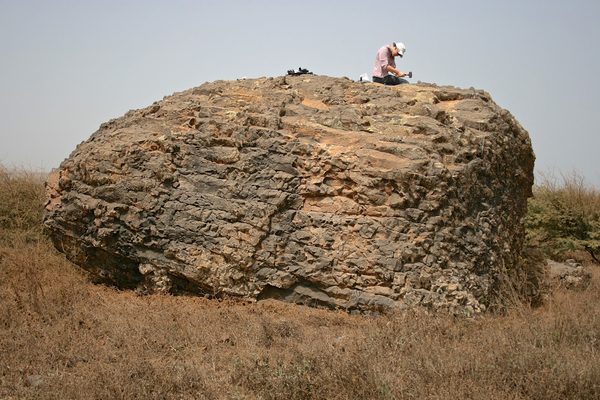Scientists have found evidence of an unprecedented “megatsunami” off
the Cape Verde Islands that occurred some 70,000 years ago. Caused
by sudden volcanic collapse, the 800-foot wave would have engulfed what
is now Santiago Island, some thirty miles away. That estimate, which
was published today in Science Advances, could prompt scientific community to re-evaluate the threat of catastrophic collapses near coastal communities. When volcanoes collapse, the resulting landslides can cause tsunamis of
varying severity. Previous research proposed a gradual model for
volcanic breakdown, which would result in multiple smaller waves. But a series of van-sized boulders, found nearly 2,000 feet inland,
suggest otherwise. Lead author Ricardo Ramalho noted that the boulders
were composed of marine rock, while the surrounding terrain was made of
young volcanic rock. These shoreline boulders were most likely deposited by a massive
wave, Dr. Ramalho and colleagues argue. They calculated the height of
the wave based on the weight of the rocks, many of which weigh several
hundred tons. “We were all very surprised by the findings,”
Ramalho says, “especially because we found them by chance. When we
realized the potential implications of these findings, we were naturally
excited (academically speaking). But also respectful of what this
represents in terms of hazard.”
Ramalho stresses that, while megatsunamis are devastating, they are also incredibly rare.“These
are what we scientists call ‘very low frequency, very high impact
events,’” Ramalho says. “Due to their very low frequency, we estimate
that the probability for them to happen again is very small. But they
may and will happen nevertheless, at some point in time. And since their
impact can be absolutely devastating, we need to be vigilant and
improve our society’s resilience to their possible occurrence.”
Like
most natural disasters, tsunamis cannot be prevented by technology. But
there are ways to improve our resilience to them, Ramalho says. Further
research, particularly on what triggers flank collapse, could help
society to better understand the hazards associated with these events.Meanwhile,
improved monitoring networks could provide additional warning time
before a collapse. While some of these networks are able to detect
volcanic unrest, many aren’t designed to pick up on the ground
deformation that occurs prior to flank collapse.But perhaps most importantly, a thorough response plan is essential to minimizing damage in the wake of natural disaster.“We
need to start thinking, coolly and rationally, what can be done in
terms of disaster risk reduction,” Ramalho says. “How may we respond to
such a crisis, and what measures can be taken at short, medium, and long
term to increase our society’s resilience to their threat? For example,
better territorial and urban planning help in mitigating the effects of
natural catastrophes in general, and this would not be an exception –
and that can be implemented at any time.
